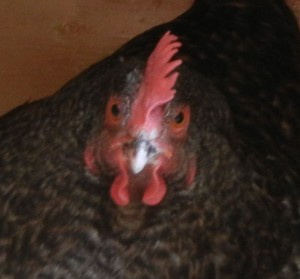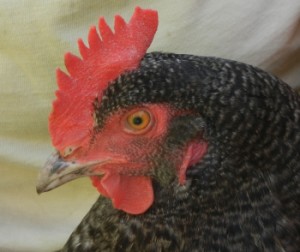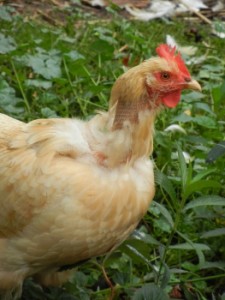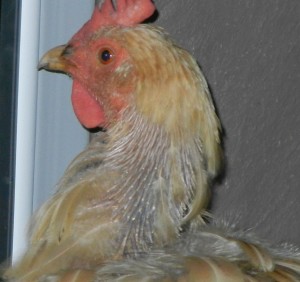The Hen Herald apologizes for the lapse of a couple of issues and we hope we did not lose any readers to the competition. It was a very busy end of the summer, but winter is approaching and the staff here at HH will find plenty of time to write on the many cold rainy days and nights ahead.
This reporter has known for sometime that chickens have very good eyesight, especially when it comes to detail. Nothing gets past them when it is new items in their environment. That’s why it is very important that if a person is working with chickens that they do not present something new to them at the same time. Denise reports that several times in the past she has wondered why her chickens were running in fear from her when she approached them, only to realize she was carrying something they had never seen before.
Humans like to think of themselves as superior to other animals; when it comes to vision, birds have us beat hands down. Here is an excerpt from an article that explains bird and chicken vision quite well.
“Based on our analysis, birds have clearly one-upped us in several ways in terms of color vision,” said study author Dr. Joseph C. Corbo of Washington University School of Medicine in St. Louis, Mo. ‘Color receptor organization in the chicken retina greatly exceeds that seen in most other retinas and certainly that in most mammalian retinas.’ Birds likely owe this exceptional color vision to not having spent a period of evolutionary history in the dark, according to Corbo. Night-vision relies on light-sensitive photo-receptors in the retina called rods, while daytime vision relies on receptors called cones. During the age of the dinosaurs, most mammals became nocturnal for millions of years. Birds, now widely believed to be descendants of dinosaurs, never spent a similar period as nocturnal animals. As a result, birds have more types of cones than mammals. ‘The human retina has cones sensitive to red, blue and green wavelengths,’ explained Corbo. ’Avian retinas also have a cone that can detect violet wavelengths, including some ultraviolet, and a specialized receptor called a double cone that we believe helps them detect motion.’ In addition, most avian cones have a specialized structure that Corbo compares to ‘cellular sunglasses”, or a lens-like drop of oil within the cone that is pigmented to filter out all but a particular range of light.” ~ http://consumer.healthday.com/eye-care-information-13/eye-and-vision-problem-news-295/chickens-may-provide-clues-to-color-vision-636123.html

And chickens have another advantage over humans in eyesight: the placement and set of their eyes gives them a very large field of view and depth perception at the same time. The chicken eye is placed on the side of the head (each eye seeing from beak to almost the tail), but the eye in the socket is tipped slightly forward thus giving them binocular vision almost as good as humans.

As is clearly visible from the photos, chickens have us in their sights at all times. The binocular vision of chickens helps them to be very precise with their bills and the gathering of food, and the wide view of the world helps them keep an eye out for potential predators. No food, moving or still, can outwit the chicken with its excellent color and motion vision.

Molting happens once a year for Denise and Andrea’s chickens. Henny started the molt again this year and is already looking good and back to laying eggs. The story is different for Sky, who went almost naked this year and her feathers are only partially grown in. “It was pretty bad!” Denise exclaims and then went on to describe the denuding of her hen. “She lost almost all the feathers on her neck, except for two which stuck straight out of her skinny neck. She also lost most of the
feathers on her chest and bottom, and her entire tail, and a long stripe down her back; it looked like someone shaved her.”

Denise was able to get a few pictures and shares them with the readers, but says “Sky knew she looked bad and did not want her photo taken, we were lucky we got anything, it took two of us to get some of the pictures”. Andrea reports that the only thing worse than a naked chicken is watching the feathers start to come back in. “Imagine large sewing needles underneath your skin poking through and stretching your skin for about ½ inch before they break through. I don’t know if that is what is really happening, but it sure is what it looks like.” All this reporter can say is OUCH!
Penny is boss of the yard. Penny has finally established herself as top chicken in the yard, so she has settled down and rarely has to enforce her status with physical contact anymore. All she has to do is give one of the other hens the “stare” and a little head nod and they get out her way. She has also taught this to the cats, but it took some reinforcement at first. There were many times this summer that the cats were seen racing through the yard with Penny lumbering behind at a slow jog. If she wants the cats to move, she will walk right up to within six inches of them and gives them the eye. At this time the cats begin to look panicked and their eyes dart left and right looking for the escape route. Then the special head nod comes from Penny and the cats are out of there. If she feels like it, she will chase them a few steps. Truly another power of the chicken’s eye.